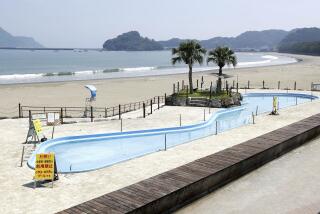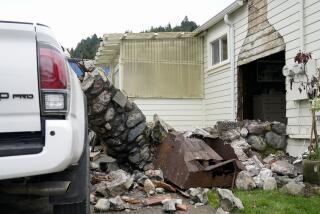Small amounts of radiation headed for California, but no health risk seen
- Share via
Small amounts of radioactive isotopes from the crippled Japanese nuclear power plant are being blown toward North America high in the atmosphere over the Pacific Ocean and will reach California as soon as Friday, according to experts.
A network of sensors in the U.S. and around the world is watching for the first signs of that fallout, though experts said they were confident that the amount of radiation would be well within safe limits.
Operated by the Environmental Protection Agency, the U.S. network known as Radnet is a system of 100 radiation monitors that work 24 hours a day, spread across the country in places such as Anaheim, Bakersfield and Eureka. In addition, a network of 63 sensors is operated by the Comprehensive Test Ban Treaty Organization, an international agency allied with the United Nations.
Photos: Earthquake and nuclear crisis in Japan
Atmospheric experts said the material should begin showing up on the West Coast as early as Friday, though it could take up to an additional week for the 5,000-mile trip from Japan to Southern California. Although the organization has told its member countries that the first indication of radiation would hit on Friday, the plume from a North Korean nuclear test in 2006 took about two weeks to travel to North America, U.N. officials said.
The Nuclear Regulatory Commission, which oversees the U.S. nuclear industry, said Wednesday that it did not expect dangerous levels of radioactivity to hit the West Coast, Hawaii, Alaska or U.S. territories in the Pacific. But whatever levels reach the U.S. initially are likely to increase in subsequent days, because radioactive emissions from the damaged Fukushima Daiichi nuclear power plant have grown since the disaster began Friday. The NRC sharply raised its warning to American citizens in Japan, urging them to evacuate an area within 50 miles of the Fukushima complex. Japanese authorities have ordered an evacuation within about 12 miles of the plant.
The NRC released computerized projections showing that within half a mile of the plant, radiation levels were so high that one could receive a fatal dose, and that even 50 miles away one could receive more than 16 times the average annual dose all people are exposed to from natural sources.
Those numbers were sharply higher than ones the NRC released days earlier. But although the Fukushima reactors are leaking more radiation now, experts continued to say that the particles would wash out of the atmosphere before they could reach the U.S.
So far, Tokyo Electric Power Co., which operates the Fukushima facility, and the Japanese government have not released any measurements or estimates of the total amount of radioactivity released by the accident. These numbers would be crucial to better project whether the material could affect other Asian nations, the Pacific islands or even the U.S.
Edwin Lyman, a specialist at the nuclear watchdog group Union of Concerned Scientists, said that although it was true that the more radioactivity released in Japan the more could migrate away from the region, he did not think the U.S. was at serious risk.
“We can never say never,” Lyman said. “My judgment is that there will probably be measurable radiation, but except for a few hot spots it is not something we should really worry about.”
Lyman said that the NRC’s warning Wednesday to Americans in Japan to evacuate 50 miles from the Fukushima reactors was a long-overdue admission that the agency’s prior warnings of a 10-mile exclusion zone from U.S. reactors during an emergency was inadequate.
Key federal officials involved in the Radnet monitoring program have so far not disclosed their predictions for U.S. radioactive exposure. The projections are being developed by the National Atmospheric Release Advisory Center operated at the Lawrence Livermore National Laboratory in Northern California. The center, part of the Energy Department, uses sophisticated models on supercomputers to project the movement of radioactive particles and other toxic substances through the atmosphere.
However, a computer model of atmospheric movements developed by the Belgian Institute for Space Aeronomy shows that the Fukushima plumes could travel across the Pacific, though the levels of radioactivity that could reach the West Coast of the U.S. remain unclear.
It appears that all of the models, however, are not based on measurements of radioactivity at the source and a projection of actual radioactive fallout in the U.S., but rather project a relative scale of radioactivity. Since Japanese authorities have said little about the amount of the releases at Fukushima, nobody can say how much radioactivity will hit California.
The models show that even with prevailing easterly winds, the plumes whip back and forth over a wide area of Japan’s east coast, Russia’s Kamchatka peninsula and Alaska’s Aleutian Islands. It is unknown whether nuclear fallout is hitting the vast wilderness of northeastern Asia.
Of particular concern, however, is radiation emanating from Fukushima’s No. 3 reactor. That reactor uses plutonium fuel, which poses a special health risk even in small quantities if the fallout were to reach U.S. shores.
A leading radiological health expert at the Centers for Disease Control and Prevention, speaking on condition of anonymity, said Wednesday that the CDC was still confident that there would be no serious health consequences here. But CDC officials are watching the situation carefully.
“We have a saying: ‘Modeling is OK, but measurement is everything,’” he said.
The Environmental Protection Agency said that it was watching the situation closely, but that its Radnet system had not yet detected radioactivity. It has added seven additional portable radiation monitors: two in Guam, three in Alaska and two in Hawaii.
Photos: Earthquake and nuclear crisis in Japan
More: Articles, videos and graphics on radiation exposure, nuclear crisis







